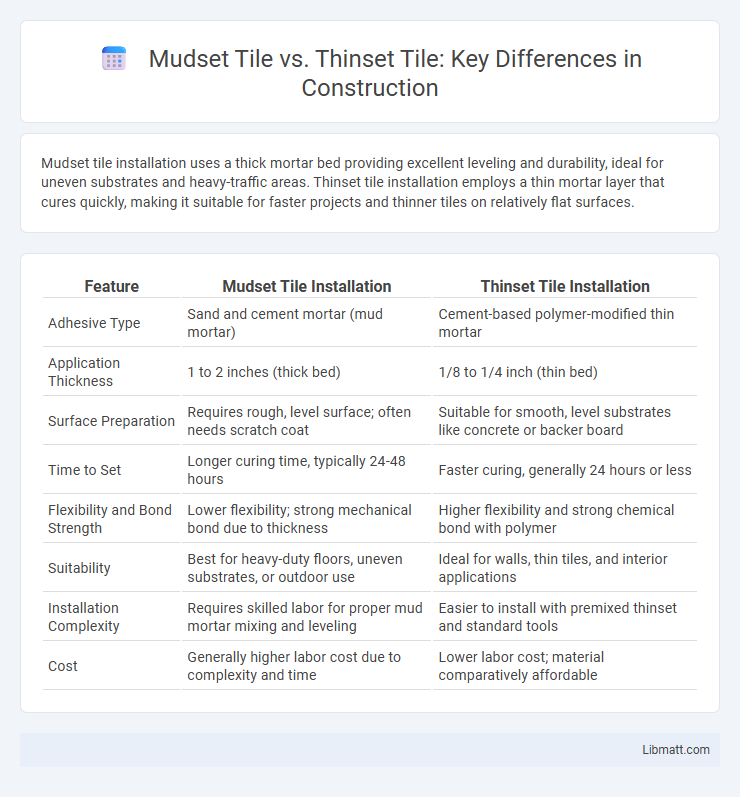Mudset tile installation uses a thick mortar bed providing excellent leveling and durability, ideal for uneven substrates and heavy-traffic areas. Thinset tile installation employs a thin mortar layer that cures quickly, making it suitable for faster projects and thinner tiles on relatively flat surfaces.
Table of Comparison
| Feature | Mudset Tile Installation | Thinset Tile Installation |
|---|---|---|
| Adhesive Type | Sand and cement mortar (mud mortar) | Cement-based polymer-modified thin mortar |
| Application Thickness | 1 to 2 inches (thick bed) | 1/8 to 1/4 inch (thin bed) |
| Surface Preparation | Requires rough, level surface; often needs scratch coat | Suitable for smooth, level substrates like concrete or backer board |
| Time to Set | Longer curing time, typically 24-48 hours | Faster curing, generally 24 hours or less |
| Flexibility and Bond Strength | Lower flexibility; strong mechanical bond due to thickness | Higher flexibility and strong chemical bond with polymer |
| Suitability | Best for heavy-duty floors, uneven substrates, or outdoor use | Ideal for walls, thin tiles, and interior applications |
| Installation Complexity | Requires skilled labor for proper mud mortar mixing and leveling | Easier to install with premixed thinset and standard tools |
| Cost | Generally higher labor cost due to complexity and time | Lower labor cost; material comparatively affordable |
Introduction to Mudset and Thinset Tile Methods
Mudset tile installation uses a thick, sand-based mortar bed that provides a sturdy, level foundation ideal for heavy tiles and uneven substrates. Thinset tile installation employs a cement-based adhesive mixed with water or latex, creating a strong bond suitable for most wall and floor tiles with a faster curing time. Selecting between mudset and thinset depends on project requirements such as substrate condition, tile type, and structural needs.
What is Mudset Tile Installation?
Mudset tile installation involves applying a thick mortar bed, typically 1 to 2 inches thick, as a stable and durable base for setting tiles, especially large-format or heavy tiles. This method uses a mixture of sand, cement, and water to create a solid substrate that offers excellent load distribution and moisture resistance. Mudset installations are commonly preferred for areas requiring high strength and longevity, such as commercial floors or exterior patios.
What is Thinset Tile Installation?
Thinset tile installation involves applying a thin layer of cement-based adhesive mortar directly onto a substrate to securely bond tiles in place. This method offers superior strength and flexibility, ensuring tiles remain firmly attached even under shifting conditions. Compared to mudset tile installation, thinset enables faster curing times and requires less material, making it a preferred choice for modern tiling projects.
Key Differences Between Mudset and Thinset
Mudset tile mortar consists of a thick mixture of sand and cement, providing a strong, stable base ideal for heavy or uneven substrates, while thinset is a lightweight, cement-based adhesive used primarily for bonding tiles directly to a flat surface. Mudset requires a longer curing time and offers excellent moisture resistance, making it suitable for traditional tile installations, whereas thinset sets quickly and is more convenient for modern, fast-paced projects. Your choice depends on the installation environment and the need for durability versus speed and ease of application.
Pros and Cons of Mudset Tile
Mudset tile offers superior durability and soundproofing benefits due to its thick mortar base, making it ideal for high-traffic areas or radiant floor heating systems. Its main drawbacks include longer installation time and the need for skilled labor, which can increase overall project costs. Your choice of mudset tile ensures a robust, long-lasting floor but requires careful planning and expertise to avoid uneven surfaces or cracking.
Pros and Cons of Thinset Tile
Thinset tile adhesive offers strong bonding and durability, making it ideal for most tile installations including floors and walls. Its pros include easy application, resistance to moisture, and compatibility with various substrates, ensuring long-lasting results for your tiling projects. On the downside, thinset requires proper mixing, can be challenging for beginners, and may not be suitable for heavy, large-format tiles compared to mudset methods.
Best Applications for Mudset Tiles
Mudset tiles excel in heavy-duty applications such as shower pans, floors with radiant heating, and large-format tile installations due to their robust, thick-bed mortar base that provides superior stability and moisture resistance. Their high compressive strength makes them ideal for commercial environments and areas subject to heavy foot traffic or dynamic loads. Mudset tiles are also preferred for custom slopes on floors and curbs, ensuring effective drainage and long-term durability in wet areas.
Best Uses for Thinset Tiles
Thinset adhesive is ideal for installing ceramic, porcelain, and natural stone tiles on both floors and walls, especially in moisture-prone areas like kitchens and bathrooms. Thinset's strong bonding properties make it suitable for thin tiles and large format tiles, providing durability and resistance to cracking under heavy foot traffic. If you want reliable adhesion and long-lasting tile installations, using thinset ensures optimal performance and versatility for your tiling projects.
Cost Comparison: Mudset vs Thinset
Mudset tile installation typically costs more due to the thicker mortar bed and increased labor time, averaging around $10 to $15 per square foot, while Thinset tile installation ranges from $5 to $10 per square foot, making it a more budget-friendly option. Mudset provides superior strength and durability, which can justify the higher initial investment for heavy-duty applications. If you aim to balance cost and performance, your choice between mudset and thinset should depend on the specific requirements of your tiling project.
Which Tile Setting Method is Right for You?
Mudset tile installation provides a durable, thick mortar bed ideal for uneven surfaces and heavy-duty applications, ensuring long-term stability. Thinset tile setting offers a faster, more flexible installation with a thinner adhesive layer, best suited for flat and properly prepared substrates. Your choice depends on project requirements, surface conditions, and desired installation speed.
Mudset tile vs Thinset tile Infographic

 libmatt.com
libmatt.com